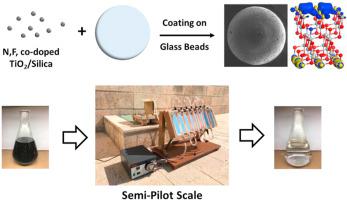Chemosphere ( IF 8.1 ) Pub Date : 2021-02-19 , DOI: 10.1016/j.chemosphere.2021.129903 Yeganeh Kosar Hashemi , Mohammad Tavakkoli Yaraki , Sina Ghanbari , Leily Heidarpoor Saremi , Mohammad Hadi Givianrad

|
Visible-light driven photocatalysts are of great importance in wastewater treatment. In this work, fluorine and nitrogen co-doped titanium dioxide/silica nanocomposite (F–N–TiO2/SiO2) was synthetized using a sol-gel approach. The as-developed nanocomposite was well characterized using different techniques. In particular, an anatase structure with high surface area (345.69 m2/g) and a band gap of 2.97 eV were observed for the as-synthesized nanocomposite, which makes it a potential candidate for photocatalytic applications under visible light. A systematic density functional theory calculation was performed to get more insight into the effect of dopant atoms on the band gap of TiO2 nanoparticles. To enhance the reusability of the photocatalyst in semi-pilot scale, the as-developed nanocomposite was immobilized onto the glass beads by coupling dip-coating and heat attachment methods. A semi-pilot scale custom-designed fixed-bed photoreactor was used to evaluate the photocatalytic performance of the as-developed nanocomposite under both visible and solar irradiations. A mixture of three azo dyes (i.e., basic red 29, basic blue 41 and basic yellow 51) was used as the model industrial wastewater. The analysis of the wastewater showed that the complete removal of the pollutants under visible light and sunlight can occurred at pH of 3 and flow rate of 280 mL/min. The durability results demonstrated the successful degradation of the pollutants for five cycles. The results of this study show how careful controlling the operational parameters as well as using a highly photocatalytic nanomaterial can lead to successful decontamination of organic water pollutants. This approach might open up new windows to the future applications of photocatalytic nanomaterials for wastewater treatment.
中文翻译:

锐钛矿型F,N共掺杂TiO 2 / SiO 2纳米复合材料在可见光下对有机水污染物的光降解:半试厂实验和密度泛函理论计算
可见光驱动的光催化剂在废水处理中非常重要。在这项工作中,使用溶胶-凝胶法合成了氟和氮共掺杂的二氧化钛/二氧化硅纳米复合材料(F-N-TiO 2 / SiO 2)。使用不同的技术可以很好地表征已开发的纳米复合材料。特别地,对于合成后的纳米复合材料,观察到具有高表面积(345.69 m 2 / g)和带隙为2.97 eV的锐钛矿结构,这使其成为可见光下光催化应用的潜在候选者。进行了系统的密度泛函理论计算,以更深入地了解掺杂原子对TiO 2带隙的影响纳米粒子。为了提高光催化剂在半试规模上的可重复使用性,通过结合浸涂和热附接方法将已开发的纳米复合材料固定在玻璃珠上。使用半中试规模定制设计的固定床光反应器来评估已开发的纳米复合材料在可见光和太阳光下的光催化性能。三种偶氮染料的混合物(即,碱性红29,碱性蓝41和碱性黄51)作为模型工业废水。对废水的分析表明,在pH为3且流速为280 mL / min的情况下,可以在可见光和日光下完全去除污染物。耐久性结果表明污染物可以成功降解五次循环。这项研究的结果表明,精心控制操作参数以及使用高度光催化的纳米材料可以成功地去除有机水污染物。这种方法可能为光催化纳米材料在废水处理中的未来应用打开新的窗口。











































 京公网安备 11010802027423号
京公网安备 11010802027423号